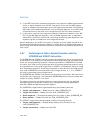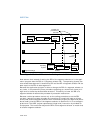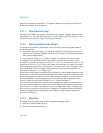
5-36 Vol. 3
PROTECTION
5.10.2 Checking Read/Write Rights (VERR and VERW Instructions)
When the processor accesses any code or data segment it checks the read/write priv-
ileges assigned to the segment to verify that the intended read or write operation is
allowed. Software can check read/write rights using the VERR (verify for reading)
and VERW (verify for writing) instructions. Both these instructions specify the
segment selector for the segment being checked. The instructions then perform the
following operations:
1. Check that the segment selector is not null.
2. Checks that the segment selector points to a segment descriptor that is within
the descriptor table limit (GDT or LDT).
3. Checks that the segment descriptor is a code or data-segment descriptor type.
4. If the segment is not a conforming code segment, checks if the segment
descriptor is visible at the CPL (that is, if the CPL and the RPL of the segment
selector are less than or equal to the DPL).
5. Checks that the segment is readable (for the VERR instruction) or writable (for
the VERW) instruction.
The VERR instruction sets the ZF flag in the EFLAGS register if the segment is visible
at the CPL and readable; the VERW sets the ZF flag if the segment is visible and writ-
able. (Code segments are never writable.) The ZF flag is cleared if any of these
checks fail.
5.10.3 Checking That the Pointer Offset Is Within Limits (LSL
Instruction)
When the processor accesses any segment it performs a limit check to insure that the
offset is within the limit of the segment. Software can perform this limit check using
the LSL (load segment limit) instruction. Like the LAR instruction, the LSL instruction
specifies the segment selector for the segment descriptor whose limit is to be
checked and a destination register. The instruction then performs the following oper
-
ations:
1. Check that the segment selector is not null.
2. Checks that the segment selector points to a segment descriptor that is within
the descriptor table limit (GDT or LDT).
3. Checks that the segment descriptor is a code, data, LDT, or TSS segment-
descriptor type.
4. If the segment is not a conforming code segment, checks if the segment
descriptor is visible at the CPL (that is, if the CPL and the RPL of the segment
selector less than or equal to the DPL).
5. If the privilege level and type checks pass, loads the unscrambled limit (the limit
scaled according to the setting of the G flag in the segment descriptor) into the


















